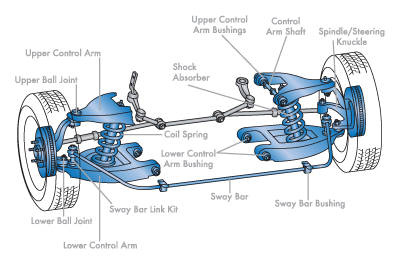Steering & Suspension Service
 |
Did you know that your steering and suspension system wears out gradually and you may not notice any problems until the system fails?
It’s important to have the suspension system checked periodically to ensure your vehicle’s drivability and safety, especially if it has been driven 80,000 km or more. Your suspension system provides steering stability and maximizes the comfort of both driver and passenger.
To maintain precise control, your car’s wheels need to be in firm contact with the road at all times. That’s where your suspension system comes in. It needs to be able to absorb bumps smoothly and steer properly, which in turn requires a fully functioning suspension system with proper wheel alignment.
Worn suspension components may reduce the stability of the vehicle and driver control, as well as accelerate wear on other suspension components and tires.
What to watch for:
Excessive tire wear, poor steering control or an off-center steering wheel are all signs that your vehicle may have steering or suspension issues. It could also indicate improper tracking that results from your car's wheels being positioned an unequal distance from the centerline.
Symptoms of bad shocks, struts, or worn springs include excessive bouncing over road bumps, loss of control during sudden stops, excessive swerving while changing lanes, front-end nose diving during quick stops, and vehicle sag in front or rear.
Shocks and Struts
Shocks and struts are part of your vehicle’s suspension system. Depending on the application of your vehicle and your daily usage, you can trust us to make the right recommendation regarding what grade and quality of shocks or struts best meets your vehicle’s needs.
The spring rate (or suspension rate) is a component in setting a vehicle’s ride height or its location in the suspension stroke. Vehicles that carry heavy loads will often have heavier springs to compensate for the additional weight that would otherwise collapse a vehicle to the bottom of its travel (stroke). Heavier springs are also used in performance applications where the loading conditions experienced by the suspension system are more extreme.
Springs that are too hard or too soft cause the suspension system to become ineffective because they fail to properly isolate the vehicle from the road. Vehicles that commonly experience suspension loads heavier than normal should have heavy or hard springs with a spring rate close to the upper limit for that vehicle’s weight. This allows the vehicle to perform properly under a heavy load when control is limited by the inertia of the load. Riding in an empty truck used for carrying heavier loads can therefore be uncomfortable for passengers because of its high spring rate relative to the weight of the vehicle. A luxury car, taxi, or passenger van would be described as having soft springs.
Vehicles with worn-out or damaged springs ride lower to the ground which reduces the overall amount of compression available to the suspension system and increases the amount of body lean. .
Steering, Suspension, and Alignment: How it works
 |
When it comes to absorbing the shocks of the road, you'd think the shock absorbers would take care of everything. But you'd only be half right.
Actually, coil or leaf springs handle the abuse of the road. Your shock absorbers handle the abuse caused by the rebound of the springs. They both work together to keep your vehicle under control. And those two components, plus a variety of control arms, shafts, rods, bushings, joints, and knuckles make up what's commonly called a conventional suspension. Many larger SUVs and pick up trucks still use this time-tested design.
 |
However, many of today's front-wheel drive cars have a strut suspension system that combines the control arms and shock absorbers of a conventional suspension into one unit, eliminating the need for a lot of other components.
Struts cost more, but they do more than conventional shock absorbers. Also, there's less stuff to break.
No matter what kind of suspension you have, its operation is affected by your car's alignment, which determines everything from the position of your steering wheel to how your tires actually touch the road.
